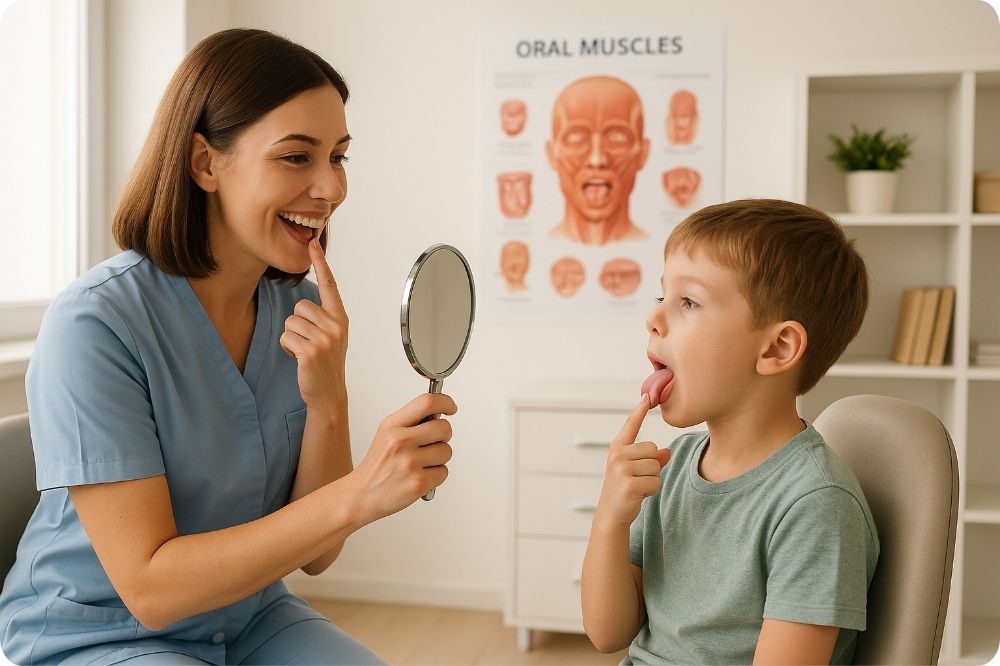
Speech disorders affect children and adults regarding the clarity of their speech and how confident they feel when communicating. These speech disorder battles are often associated with the incorrect function or placement of the tongue and facial muscles. This is where myofunctional therapy in Fairview comes into play – a non-invasive treatment used to retrain the facial and mouth muscles.
If your child has trouble saying certain sounds or you notice some unusual oral habits, such as tongue thrusting or open-mouth breathing, myofunctional therapy may help! Therapy isn’t just for oral speech sounds; it is also used for different functions like chewing, swallowing, breathing, and posture. Therapy addresses orofacial health comprehensively.
What Is Orofacial Myofunctional Therapy?
Orofacial myofunctional therapy involves a series of simple, repetitive exercises for the tongue, lips, jaw, and facial muscles. The goal of therapy is to correct those poor muscle habits and establish the proper resting posture of the tongue and lips. It is especially effective when addressing speech disorders treatment resulting from tongue or muscular function.
It can be a part of an interdisciplinary plan of care with speech, orthodontic, and ENT services. When the tongue and lips are moving correctly, the sounds are clearer and easier to produce from the beginning.
How Tongue Thrust Therapy Helps Speech Clarity
Tongue thrust, where the tongue pushes forward when a person speaks or swallows, is a common complaint among patients with speech disorders. This, down the road, can affect speech and how teeth develop. It retrains the tongue position and movement to improve speech and help align a person’s bite.
Benefits of tongue thrust therapy include:
- Better articulation of “s,” “z,” and “th” sounds
- Improved control of tongue placement
- Helps orthodontic treatment
- Decrease the chance of future dental intervention.
What to Expect from Myofunctional Therapy Sessions
Each myofunctional therapy session is customized based on age, condition, and personal goals. Exercises are simple and can be done at home. Most sessions focus on awareness, muscle strengthening, and habit correction. Progress is often noticeable within weeks, especially when therapy is started early.
If you’re looking for help with speech disorders, a dentist near you who offers myofunctional therapy can work with other specialists to develop a full treatment plan.
How Can You Tell If You Need Myofunctional Therapy?
Myofunctional therapy is not just for kids! Teens and adults can benefit from targeted muscle training, too. Here are a few signs you could benefit from therapy:
- Having trouble pronouncing certain sounds.
- Tongue resting between or on teeth.
- Mouth breathing while awake or sleeping.
- Trouble chewing or swallowing.
- Difficulty relearning oral musculature and swallowing after braces or orthodontic work.
If you have experienced any of these things, it may be time to look into or focus on orofacial myofunctional therapy for a permanent fix.
Rebuild Confidence Through Speech-Friendly Dental Care – Visit Today!
Whatever higher support you decide upon to help address speech concerns or establish positive oral habits, it makes all the difference. At Fairview Dental Clinic, we offer personalized myofunctional therapy to help you or your child achieve long-lasting results. Contact us today for a myofunctional appointment, and start your path towards clear speech and healthy function.
FAQs
Can myofunctional therapy replace speech therapy?
Not always. It’s best to use myofunctional therapy as a complement to speech therapy, specifically for sound correction and clarity.
Is the therapy painful?
No, the exercises are gentle and designed to be safe and comfortable.
How young can a child start myofunctional therapy?
Many children start as young as age four, especially if the symptoms interfere with eating or speaking.
How long until I see results from myofunctional therapy?
Some people notice change within a few weeks, but it can take months to see full results; this depends on the individual case.
Can adults benefit from myofunctional therapy?
Yes! Adults with sleep apnea, TMJ or long-term speech difficulties can benefit from myofunctional therapy.






